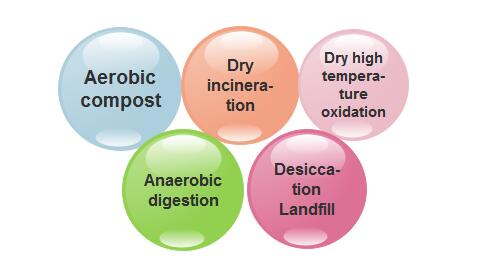|
Project |
Aerobic compost | Anaerobic digestion | Dry incineration | Dry landfill | Drying + high temperature oxidation |
| Technical applicability | Only limited to organic hazardous substances and heavy metal-rich sludge rich in organic matter | Applicable to some sludge rich in organic matter | Suitable for domestic sludge and ordinary industrial sludge, it needs to be accepted by suitable thermal power plants and industrial kilns | Applicable to all sludge, large land area, and potential hazards of secondary pollution |
Suitable for domestic sludge and most common industrial sludge and industrial hazardous waste, dry slag is easy to be recycled |
|
Footprint |
Large | About 1/2 of the aerobic compost | About 1/5 of aerobic compost | The floor space increases year by year | Smallest footprint |
| Management operations | general | general | high degree of automation | Average degree of automation |
high degree of automation |
|
Sludge outlet after disposal |
According to the buyer’s demand for sludge fertilizer, it is more complicated | According to the buyer, it is more complicated | Finished products are sent to thermal power plants and industrial kilns | Send to landfill, far away |
Can be purified on-site, use of building materials, or thermal power plants, landfills |
|
Sludge main outlet reliability |
More difficult | general | reliable | Reliable, limited by land |
reliable |
|
Other ways of sludge |
Land consumption (without fertilizer production) | Land consumption | Fertilizer, land consumption, alternative energy | Fertilizer (perishable, not easy to store), land consumption, alternative energy (high water content, limited incinerator) |
Flexible use |
|
Resource recycling |
Sell rotted mud as fertilizer | Partially recovered biogas heat energy can be used as medium soil | Thermal power plants burn energy and can also be used as alternative energy | N/A |
Recycling dry slag heat energy and liquid organic substances, oil products, can also be used as raw materials for building materials products |
|
Secondary pollution |
Need to strictly control odor pollution | The water content of the sludge is high, so it is necessary to pay attention to the environmental pollution caused by the transportation loss | N/A | N/A |
N/A |
| Limitation factor | Heavy metals, pathogens | Heavy metals, pathogens | There are basically no special requirements, the calorific value requirements of the dried products | Basically no special requirements |
Basically no special requirements |
CONTACT US
Address: No. 22 Binhe Road, Luoyang City, Henan Province, China
Tel: +86 379 64318689
Cell: +86 18237958898
E-mail:sales@lcdri.com
OUR PERSPECTIVE
Technology innovation
Energy & resource saving
Environment protection
Search
OFFICE HOURS
Mon-Fri: 8:30-17:30



